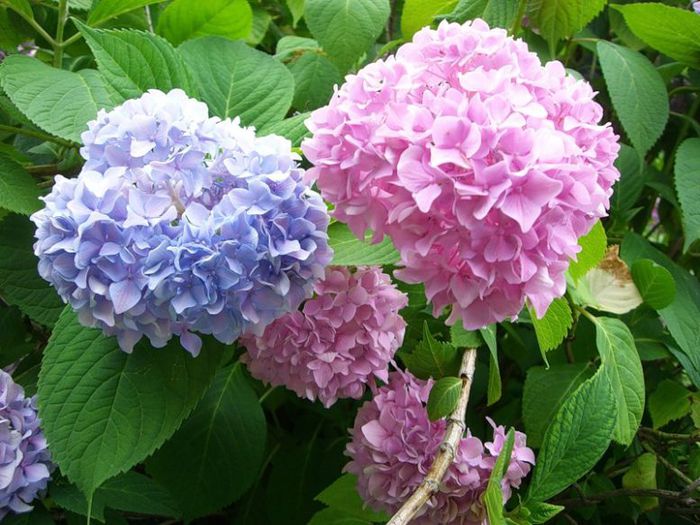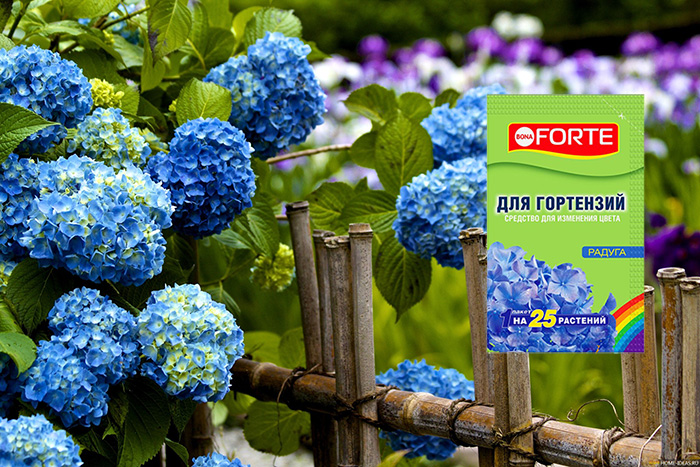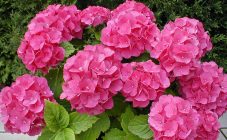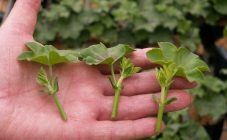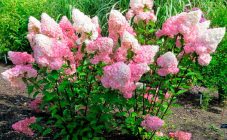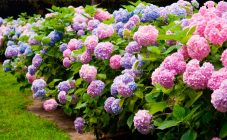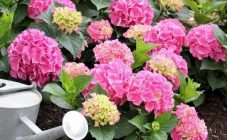Content:
The spectacular hydrangea shrub flower has recently become popular. Beautiful lush blossoms are used as garden decoration. This plant is also attractive to gardeners because some varieties can easily change their color. Experimental lovers are interested in how to make a blue hydrangea? It turns out that for this you need to water and fertilize the crop with some means. But it is important to do this comprehensively and at a specific time.
Varieties that change color
Among the common types of hydrangeas are:
- Tree-like;
- Paniculate;
- Dubolisty;
- Sadovy, etc.
Each of them looks gorgeous, but only a garden hydrangea has the ability to change the shade of the petals.
Garden hydrangea
The more common name is large-leaved. Shrub-flower stretches up to 1.4-1.8 m. The shape of the bush resembles a ball. The peculiarity of this species is in bright emerald leaves. They are large, oval. Notches are present. The caps of the inflorescences are fleshy. The diameter of each inflorescence is about 15-20 cm. Shoots begin to woody only after a year. Because of this feature, the garden hydrangea needs shelter for the winter. Fortunately, dwarf varieties have now appeared. They are intended for breeding in apartments.
Among the varieties of large-leaved hydrangea, there are those that can change color, depending on the acidity of the soil and the content of aluminum metal in the soil. Color changes due to the pigment substances anthocyanins. They are the ones that react to soil pH. In addition, such flowers contain another pigment matter - delphinidin-3-monoglycositis. The pigment also reacts to the conditions in which a flowering crop is grown, in particular to the presence of aluminum in the ground.
In order for the hydrangea to bloom blue, the gardener is recommended to buy the following varieties of large-leaved flower:
- Endless summer;
- Blue Wave;
- Masya;
- Renata Steiniger, etc.
All these varieties have a long flowering period. The first inflorescences are observed in the middle of summer. Flowers delight summer residents before the onset of frost.
Watering plants for blue color
How to water the hydrangea so that it changes color to blue? This is a topical issue. It is known that aluminum affects the appearance of blue coloration. This means that it is important to provide the land in which the flower is located with this metal.
How, what exactly and when should it be done? It is worth making a reservation that you cannot change the formed inflorescences. All work on making the plant blue begins at a certain time: this is either early spring or the moment of planting.
In this case, it is worth using forms of the substance that would easily penetrate the ground, and then be absorbed by the root hairs of the hydrangea. Among such substances is aluminum sulfate. It is the answer to the question "how to water the hydrangea for blue?" It is dissolved in water for irrigation. For a 10-liter bucket, 25-35 grams of aluminum sulfate is taken. One adult bush needs 2 of these buckets.
You can also use dry matter of aluminum sulfate.It is buried in the soil under the bush at the rate of 200-250 grams per half square meter. After the procedure, the soil is thoroughly watered and mulched with sawdust, pine needles or grass.
An effective remedy is burnt alum for hydrangeas. This is another answer to the question "how to water the hydrangea to make it blue?" They are volcanic minerals. Among the components of the substance are aluminum and alkaline potassium. That is, this substance is aluminum-potassium sulfate. There is another type of substance - potassium alum for hydrangeas. This is the same sulfate, only with water molecules. It looks like a snow-white powder of crystals. It dissolves perfectly in water. Burnt alum for hydrangea implies the same use as potassium alum. The difference between these substances is in their solubility in water. Burnt ones dissolve poorly.
How to use alum on hydrangeas? Usually 15 grams of alum is dissolved in 4-5 liters of water. Also dry powder can be embedded in the root circle. The consumption will be 150 grams per half square meter. An important condition is that it is necessary to carry out the procedure for saturating the earth with aluminum every 14-18 days from the beginning of spring. After the plant turns blue, the procedure is stopped for a while.
Fertilization
There should also be a high-quality feeding of the flower culture. What is the best way to water a blue hydrangea garden? Complex mixtures should be taken such where the main element is potassium. It is allowed to add nitrogen, but in small amounts.
How watering affects the flower
Hydrangea is translated from Latin as a vessel in which water. This is no coincidence. Watering is important in caring for a gorgeous flower. It is held every 3-4 days throughout the summer. Under an adult plant, 3-4 10-liter sprinklers with settled water are applied. If the summer is dry, watering is organized more often, but you should not overdo it. Waterlogging of the soil causes rotting and the development of fungal infections.
Soil acidity
In addition to the presence of aluminum in the earth, the changeable color depends on the acidity of the soil. For hydrangea to bloom blue, the pH must be below 5.5 pH. That is, the blue color causes acidic soil. If the pH level is 5.5-7 (the ground is neutral and slightly acidic), then the flowers will turn out to be light. If the pH is above 7 (alkaline earth), then the petals will appear pink.
How to determine acidity
- The popular method of determination is with ordinary chalk powder. It is not difficult to do it. You need to take 1 spoonful of garden soil. Mix it with 2.5 tablespoons of lukewarm water. Add half a teaspoon of chalk powder to the mixture. Mix everything and pour into a bottle with a narrow neck. Put a rubber fingertip on the bottle. There should be a minimum of air in the bottle. The mixture is shaken well and left for 15 minutes. If the fingertip has pouted, it means that the soil in the area is sour. If air appears in it, but there is not much of it, then the soil is slightly acidic. If nothing happened, then the soil is neutral.
- Garden outlets sell special litmus tests. Together with them comes a colorful instruction. It indicates which color of paper corresponds to a certain type of soil. All new pieces of paper in neutral or yellow. They must be immersed in a mixture of water and earth. In this case, one spoonful of soil is taken, 4 tablespoons of water.
- The device. Such a device most accurately determines the pH value. But the device is not cheap either.
- Another simple way to determine acidity is by weed grass. It is known that the acidic earth is attractive for ferns, plantains, cornflowers, dandelions, chamomile, sedges.Nettle, thistle, shepherd's purse, quinoa are chosen as neutral. Thyme, mustard, chicory, and spurge grow in the soil, the pH of which is above 7.
How to change acidity
Before changing the color of the hydrangea to blue, you need to make the soil acidic. The best pH is 4-5.4. If it drops less, it can negatively affect the culture.
Acidification work is carried out in the area next to the hydrangea bush. It is necessary to make an acidic soil layer of 30 cm.If planting is only planned, then the soil mixture intended for the planting pit is made acidic. You can make it sour with fresh sawdust, peat.
If acidification of the soil is required for an already planted plant, then citric, acetic acid is used here. 2 tablespoons of citric acid are used in a 10-liter bucket of water. Vinegar 9% will be needed for the same volume of water 100 grams. Such procedures are organized several times per season, starting in early spring. Mulch in the form of needles, sawdust, high-moor peat, bark can help with oxidation.
How to make a white hydrangea blue
It should be noted that the snow-white varieties of this spectacular flower do not change color. Only flowers with a pale pink, blue-whitish color are subject to a change of inflorescences. When talking about how to change the color of a hydrangea from white to blue, we mean the light color of the petals, the color of which should turn blue.
Step-by-step instruction
- In early spring, the acidity level of the soil is determined. The easiest way to do this is with a special device.
- Further, the soil is acidified. Home remedies work well for this. For example, acetic acid or citric acid. The trunk circle is mulched with sawdust, needles or high moor peat.
- Every 14-18 days, the soil is treated with aluminum sulfate or alum.
- Hydrangeas need abundant watering. Every 4 days, 30 liters of water is poured under an adult plant.
- Several times before flowering, the culture is fed. For this, potash dressings are taken with a low nitrogen content.
Helpful care tips
Once the hydrangea has been changed to blue, it is important to maintain it. For this, the acidity of the soil is kept at 4-5 pH. They also continue not often, but still water with products containing aluminum.
Experienced gardeners advise not every year to experiment with the color of the petals. A sharp change in acidity causes stress in plants. Therefore, it is best to plant several flowers in the garden, the shades of which will differ.
In order for the hydrangea to bloom blue, it is important to organize the correct complex work. It is the lengthy process that will help achieve quality results. However, novice gardeners should not worry if they failed to completely change the color the first time. Still, hydrangea belongs to the rather difficult flower crops in terms of care.
